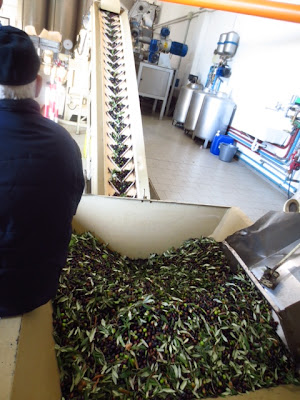People often ask me if I know the secret to authentic, genuine Italian olive oil. As a matter of fact I do, and have just received the following report from our On-The-Ground reporter with details of her in-depth investigation of the olio process.
Step 1: You need to purchase property in Italy and plant olive trees. In 6 to 9 years, they will begin to produce olives and you have successfully completed the first step to authentic Italian olive oil.
Alternatively, you can take a trip to Italy and stay with a family that has pre-existing trees. If you are short on time, I’d highly recommend this option.
Step 2: Pick the olives. You may be able to reach them from the ground, but if you are vertically-challenged, it may require a ladder or other forms of arboreal ascension. The two pictures below illustrates what is commonly referred to as the “Zacchaeus Technique”.
 |
| A local olive picker demonstrates the "Zacchaeus Technique". |
 |
| According to our Hands-On Reporter, it's "a little like milking a cow...grab up at the top, hold gently but firm and pull down." |
Step 3: Pick all the olives you can, saving plenty of time for eating, drinking, and going to festivals in quaint little Italian villages.
 |
| A festival in a quaint little Italian village. |
 |
| The local band in a festival in a quaint little Italian village. |
Step 4: Collect the olives and transport them to the “frantoio”. A literal translation means “the place where the olives get squished”. At the frantoio, all the olives are collected in the hopper. In our example, the hopper contains 317 kg (that’s 697.4 pounds to our American readers) of olives. Of note, you’ll notice a combination of green and black olives in the hopper. Based on extensive personal research, our In-The-Tree Reporter tells us that green olives usually have a little less oil but good medicinal properties (and impart a spicy taste), while black ones are more ripe and have soaked up more water from the rains. Both are desired for different reasons.
Step 5: The hopper is dumped onto a conveyor belt, which takes the collective olives to the first elevator ride of their short oleaceous life. At the top of the lift, they get a quick visual inspection by the geriatric quality control officers, then get “whirled around a bit” to suck off any remaining leaves and stems.
 |
| The Quality Control Crew |
Step 6: After a quick shower and scrub down, the olives get rinsed and take their second and final elevator ride, which finishes with their arrival in the “mush tank”. In the musher, the olives get crushed and churned at a warm temperature to create a pulpy, puree-type liquid. The picture below shows “Roberto”, our On-The Ground-Reporter’s contact in the olive business.
 |
| The rinse cycle |
 |
| The Musher |
 |
| Roberto |
Step 7: Time for the spin cycle, which separates the oil from everything else. According to our In-The-Frantoio Reporter, this machine is “super duper fast”.
Step 8: A series of filters and separators culminates in 41 kgs (90.2 lbs) of extra-virgin olive oil, ready for your gastronomic delight.
 |
| The end result....41 kilograms of extra-virgin olive oil. |
And in case you were wondering, here's the by-product of all that pressing and spinning and extracting. Some frantoios will press this again, but it loses the "extra-virgin" label.
Up next, the long anticipated answer to the pressing question: How do they get the stuff inside a cannoli?
(Editorial comment: Ginger spent 10 days at an olive farm in Montemarciano, northeast of Ancona on the Adriatic Sea. She has since left the region and surfaced in Verona (setting for Shakespeare’s Romeo & Juliet, and later took the train to visit our friend Mel in Osijek, Croatia. Stay tuned for further updates.)






.jpeg)












.JPG)
.JPG)


































